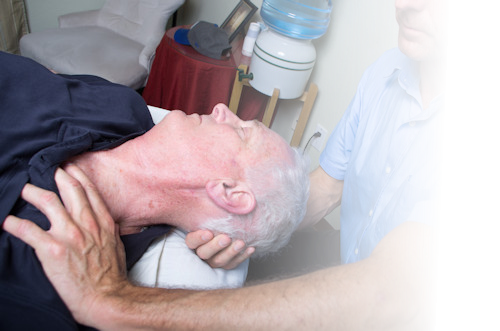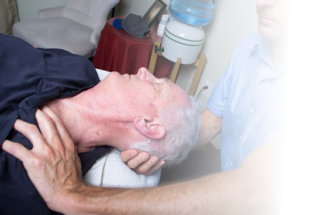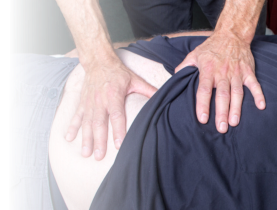
Manual Therapy Services
Services provided at Jim Stevens Manual
Therapy
For your convenience, this is a list of services I provide. Additional information is available for some by following links in each section. If you have questions about any of these, please contact me.Massage therapy:
Massage has been around since the first monkey stubbed their big toe. Massage is an approach primarily concerned with softening, soothing, and relaxing the muscles of the body. It can be very relaxing, or quite vigorous. It depends entirely on what you need on that day. Massage for injury rehabilitation is often treating specific muscles or areas within the body. A relaxing massage tends to by gentle, non-invasive, and is largely designed to soothe the patient allowing them to relax and let go of physical and mental/emotional tension. Both are incredibly beneficial. Just tell your therapist what it is you need on any given day.Pain Relief:
Sometimes pain is caused by tension, sometimes it is overuse, and frequently it is caused by trauma and injury. We can mask it with pain medicines, or take anti-inflammatory medicine to reduce the pain, but in order to get relief from the pain, we must first, discern what we have done to cause the discomfort, and second, take some action on that information in order to relieve pain.Visceral manipulation:
An osteopathic treatment method for the internal organs and their surrounding tissues. It is a bit like treating the body from the inside out. It involves listening to the body to locate areas of adhesion or injury, and gently releasing the tissues. In order for our organs and glands to work optimally, they must move freely and correctly within their environments. The bio-mechanical effects, or the effect this work has on freeing up body movement is astounding.Physiotherapy:
Ultimately, the physiotherapist works to aid the physiology or functioning of the body. Physiotherapy is closely related to physical therapy as it includes stretching and strengthening exercises. When you work with any good therapist, they will leave some responsibility to the patient. If your therapist gives you stretches or strengthening techniques, do them each day as suggested. This is you doing your part to increase the benefits of the work.Brain tissue manipulation:
A treatment method I developed to insure proper movement and health of the Central Nervous System. It is most closely related to light touch chiropractic. This work is great for brain injury and trauma including PTSD. This treatment allows the practitioner to ease the vertebra back to their correct alignment, without high velocity thrusting. This technique relies on the inherent movement (motility) of the brain, cranial nerves, and spinal cord. It is used as a diagnostic tool in locating neural impingement and vertebral misalignment.Cranial osteopathy:
Osteopathy within the cranial field is designed to facilitate the ease of movement within the cranial structure. While its primary function is working with the structural component of the cranial bones, to keep the bones moving freely and correctly, this technique also includes working with the ligaments, fascial sheathes, menengies, and arteries of the cranium.Neuro-menengial manipulation:
Based on the principles of visceral manipulation, these techniques work to free the nerves entrapped by inflammation in their surrounding tissues. When a nerve becomes irritated, its outermost covering swells at a single point, causing a budding, or a bubble to occur. This swelling prevents the nerve from moving, thereby limiting further injury. When the nerve limits movement, the entire body gets involved in a protective or defense mechanism in order to protect the nerve from permanent injury.Myo-fascial therapy:
Every muscle cell has a connective tissue membrane; this connective tissue, known as fascia, is where the muscle cell gets its strength. Every bundle of muscle cells (fascicle) is wrapped in yet another fascial membrane, and each muscle is individually wrapped in its own fascial sheath. As well as providing strength, the fascia also allows the muscles and organs to glide across one another within their shared environments. When the fascia becomes stuck, within or to an adjoining muscle, it inhibits movement, not only at the source, but also commonly throughout the body. These tension patterns created by connective tissue are called lesional chains. Myo-fascial work promotes the freeing of connective tissue sheaths within the musculo-skeletal system.Vascular manipulation:
Based on the principles of visceral manipulation, this method locates areas of reduced or stagnated blood flow, and correcting it with gentle stretches to the arteries and veins. Pain, in almost all cases is caused by a reduction of blood flow, making this work paramount in treating chronic pain. These gentle stretches cause an increase in the diameter of the blood vessel, thereby increasing blood volume to the affected area.Lymphatic drainage:
Lymphatic fluid is your extracellular fluid, and a huge part of your immune system. It keeps the individual cells lubricated and mobile, while simultaneously acting as an active transport mechanism within the body. When injury or inflammation occurs, the lymphatic fluid is drawn into the area to both cushion and protect the local tissues. The trouble begins when the swelling stays after it has served its purpose. By understanding the pulse, rhythm, and flow patterns of the lymphatic system, we are able to gently remove excess fluid from portions of the body. This method gently reduces localized swelling and edema, speeding the healing process.Lympho-fascial:
The gentlest Myo-fascial therapy available. It was created, developed, and named by Jim Stevens MT. Lympho- fascial therapy is largely based in two principles of physics; first, Nature abhors a vacuum, and second, water seeks its own level. This gentle technique applies a lift to separate the tissues creating a vacuum; the extracellular fluid is drawn into the space created, negating the vacuum, and separating the fascial sheaths, thus causing a gentle separation between the tissues and within the muscle itself.




© 2022, Jim Stevens Manual Therapy

Master Manual Therapist & Physical Trauma Specialist
Relieving pain and injury since 1994

Manual
Therapy
Services
Services provided
at Jim Stevens
Manual Therapy
For your convenience, this is a list of services I provide. Additional information is available for some by following links in each section. If you have questions about any of these, please contact me.




Massage therapy:
Massage has been around since the first monkey stubbed their big toe. Massage is an approach primarily concerned with softening, soothing, and relaxing the muscles of the body. It can be very relaxing, or quite vigorous. It depends entirely on what you need on that day. Massage for injury rehabilitation is often treating specific muscles or areas within the body. A relaxing massage tends to by gentle, non-invasive, and is largely designed to soothe the patient allowing them to relax and let go of physical and mental/emotional tension. Both are incredibly beneficial. Just tell your therapist what it is you need on any given day.Pain Relief:
Sometimes pain is caused by tension, sometimes it is overuse, and frequently it is caused by trauma and injury. We can mask it with pain medicines, or take anti-inflammatory medicine to reduce the pain, but in order to get relief from the pain, we must first, discern what we have done to cause the discomfort, and second, take some action on that information in order to relieve pain.Visceral manipulation:
An osteopathic treatment method for the internal organs and their surrounding tissues. It is a bit like treating the body from the inside out. It involves listening to the body to locate areas of adhesion or injury, and gently releasing the tissues. In order for our organs and glands to work optimally, they must move freely and correctly within their environments. The bio- mechanical effects, or the effect this work has on freeing up body movement is astounding.Physiotherapy:
Ultimately, the physiotherapist works to aid the physiology or functioning of the body. Physiotherapy is closely related to physical therapy as it includes stretching and strengthening exercises. When you work with any good therapist, they will leave some responsibility to the patient. If your therapist gives you stretches or strengthening techniques, do them each day as suggested. This is you doing your part to increase the benefits of the work.Brain tissue manipulation:
A treatment method I developed to insure proper movement and health of the Central Nervous System. It is most closely related to light touch chiropractic. This work is great for brain injury and trauma including PTSD. This treatment allows the practitioner to ease the vertebra back to their correct alignment, without high velocity thrusting. This technique relies on the inherent movement (motility) of the brain, cranial nerves, and spinal cord. It is used as a diagnostic tool in locating neural impingement and vertebral misalignment.Cranial osteopathy:
Osteopathy within the cranial field is designed to facilitate the ease of movement within the cranial structure. While its primary function is working with the structural component of the cranial bones, to keep the bones moving freely and correctly, this technique also includes working with the ligaments, fascial sheathes, menengies, and arteries of the cranium.Neuro-menengial manipulation:
Based on the principles of visceral manipulation, these techniques work to free the nerves entrapped by inflammation in their surrounding tissues. When a nerve becomes irritated, its outermost covering swells at a single point, causing a budding, or a bubble to occur. This swelling prevents the nerve from moving, thereby limiting further injury. When the nerve limits movement, the entire body gets involved in a protective or defense mechanism in order to protect the nerve from permanent injury.Myo-fascial therapy:
Every muscle cell has a connective tissue membrane; this connective tissue, known as fascia, is where the muscle cell gets its strength. Every bundle of muscle cells (fascicle) is wrapped in yet another fascial membrane, and each muscle is individually wrapped in its own fascial sheath. As well as providing strength, the fascia also allows the muscles and organs to glide across one another within their shared environments. When the fascia becomes stuck, within or to an adjoining muscle, it inhibits movement, not only at the source, but also commonly throughout the body. These tension patterns created by connective tissue are called lesional chains. Myo-fascial work promotes the freeing of connective tissue sheaths within the musculo-skeletal system.Vascular manipulation:
Based on the principles of visceral manipulation, this method locates areas of reduced or stagnated blood flow, and correcting it with gentle stretches to the arteries and veins. Pain, in almost all cases is caused by a reduction of blood flow, making this work paramount in treating chronic pain. These gentle stretches cause an increase in the diameter of the blood vessel, thereby increasing blood volume to the affected area.Lymphatic drainage:
Lymphatic fluid is your extracellular fluid, and a huge part of your immune system. It keeps the individual cells lubricated and mobile, while simultaneously acting as an active transport mechanism within the body. When injury or inflammation occurs, the lymphatic fluid is drawn into the area to both cushion and protect the local tissues. The trouble begins when the swelling stays after it has served its purpose. By understanding the pulse, rhythm, and flow patterns of the lymphatic system, we are able to gently remove excess fluid from portions of the body. This method gently reduces localized swelling and edema, speeding the healing process.Lympho-fascial:
The gentlest Myo-fascial therapy available. It was created, developed, and named by Jim Stevens MT. Lympho-fascial therapy is largely based in two principles of physics; first, Nature abhors a vacuum, and second, water seeks its own level. This gentle technique applies a lift to separate the tissues creating a vacuum; the extracellular fluid is drawn into the space created, negating the vacuum, and separating the fascial sheaths, thus causing a gentle separation between the tissues and within the muscle itself.


© 2022, Jim Stevens Manual Therapy



Master Manual
Therapist & Physical
Trauma Specialist
Relieving pain and
injury since 1994































